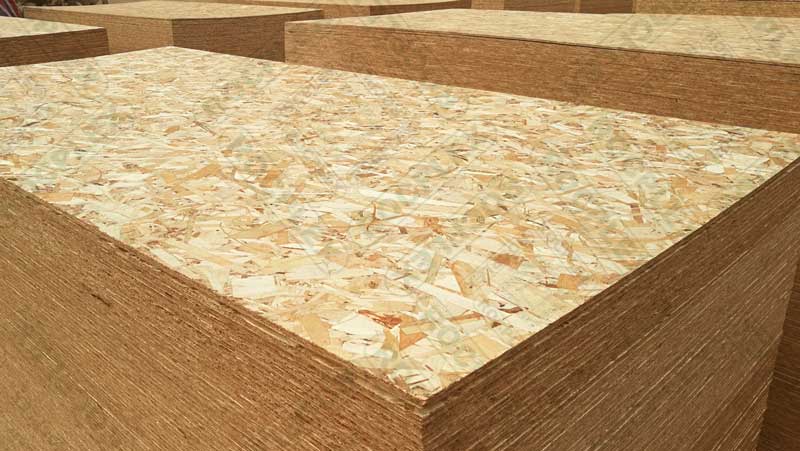Oriented Strand Board ( OSB ) is a kind of structural board made of flat narrow and long shavings which have been dried, screened, applied with adhesives and additives, and hot-pressed after directional paving. It has high strength because it is made of many layers of wood chips. In Japan and Europe and the United States, OSB is considered to be the fastest growing, most promising and technologically mature plate.
At present, the use of OSB in the United States has accounted for half of the total use of man-made panels, and has gradually replaced plywood, veneer and other man-made panels in many uses.
OSB Board component structure
It is a kind of directional structural plate made from small-diameter wood, thinning wood and wood core, processed into 40-100 mm long, 5-20 mm wide and 0.3-0.7 mm thick flakes by special equipment, and processed by deoiling, drying, gluing, directional paving, hot pressing and other processes. Its surface layer flakes are arranged longitudinally, and the core layer flakes are arranged transversely. This crisscross arrangement reorganizes the wood texture structure, completely eliminates the impact of wood internal stress on processing, and makes it extremely easy to process and moisture-proof.
Because the OSB has a directional structure, no joints, cracks, cracks, good overall uniformity, and high internal bonding strength, both the center and the edge of the OSB have a super nail holding ability that ordinary plates can't match. Relying on Germany, the kingdom of chemical industry, the adhesive used by the European plate has always maintained the leading position in the world. The formaldehyde emission of the finished product conforms to the highest European standard (European E1 standard), which can be comparable with natural wood.
Advantages and characteristics of OSB Board
1. It has high physical and mechanical properties, compact structure and high strength.
2. It has three characteristics of deformation resistance, peeling resistance and warpage resistance.
3. Anti-corrosion, mothproof, deformation resistant, and strong flame retardant.
4. Complete waterproof performance, can be permanently exposed to natural environment and wet conditions.
5. Formaldehyde emission is very low, which is a real green environmental protection product.
6. Strong nail grip, easy to saw, nail, drill, slot, plane, file or sand.
7. It has excellent heat insulation, sound insulation effect and good paint performance.
OSB performance purpose
OSB has good stability and high screw holding force. Its raw materials are mainly softwood, small-diameter hardwood, fast-growing thinning wood, etc., such as eucalyptus, fir, poplar thinning wood, etc., which have a wide range of sources and can be manufactured into large panels (such as 8 × 32 feet or 12 × 24 feet). The manufacturing process is mainly to dry, glue, orient and hot-press the shavings with certain geometric shape (usually 50 mm - 80 mm long, 5 mm - 20 mm wide, and 0.45 mm - 0.6 mm thick). The technical difficulty is high, and the equipment investment is relatively large, mainly for imported equipment, mostly for several billion or more. At present, China's "OSB" manufacturing technology and equipment production capacity are far behind those of North America and Europe. At present, the main "OSB" in the market still mainly depends on imports.
Compared with plywood, medium-density fiberboard and blockboard, OSB has low linear expansion coefficient, good stability, uniform material and high screw holding force; Because its particle is arranged in a certain direction, its longitudinal bending strength is much greater than that of the transverse, so it can be used as structural material and load-bearing member. In addition, it can be sawed, sanded, planed, drilled, nailed and filed like wood, and is a good material for building structure, interior decoration and furniture manufacturing. The disadvantage is that the thickness stability is poor, mainly because the size of the particle is different, and the direction and angle of the particle in the paving process cannot be completely horizontal and uniform, which will form a certain density gradient, which has a certain impact on the thickness stability.
The advantage of low formaldehyde emission is accepted by the market as the most promising wood-based panel in the future, and OSB has a broad space for use and development. The market is looking for the advantage of formaldehyde free release, which can be mainly used in: floors, walls and roofs, I-beams, structural isolation boards, packaging boxes, goods pallets and storage boxes, commodity shelves, industrial desktop, hardwood floor core, air baffle and guardrail, decorative wall panels, precast yard concrete molding, container floors, bowling alley, etc.
After processing, it will replace blockboard, plywood, plywood, building formwork, fireproof board, decorative board and MDF. The liner between the solid wood floor and the keel, or the base material made of composite wood floor. Structural plate of furniture and kitchenware. Lining board, interior panel, heat insulation board, sound-absorbing board, ceiling and wall panel for building. Retaining plate, ditch formwork, base plate, etc. for construction. After the OSB surface is pasted on one side, it can be used for the plain board, drawer base plate, box, cabinet partition, floor board, bed board, etc. for furniture manufacturing.
Post time: Jan-10-2023


